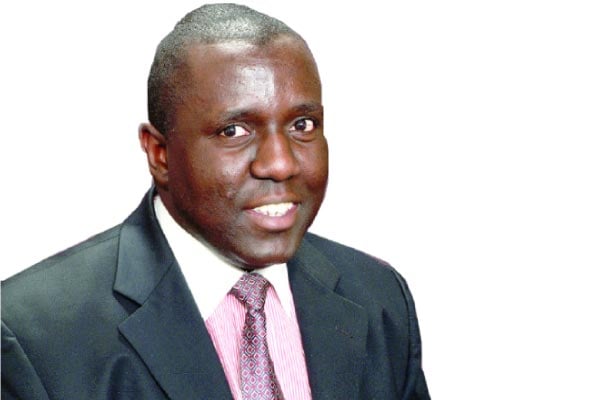Prime
Uganda in the grip of a cancer burden

Patients and caretakers wait to be attended to at the Uganda Cancer Institute in Mulago, Kampala, in 2018. Experts doubt as to whether Uganda’s healthcare system is braced for an influx of cancer patients. PHOTO/FILE
What you need to know:
- A new study undertaken by researchers from Uganda Cancer Institute (UCI) puts the cancer frequency at 125.4 per 100,000 among males, and 134.6 per 100,000 among females in the central region.
The number of new cancer cases in Uganda is more pronounced in the central region, with women more at risk in two of the three most affected regions.
A new study undertaken by researchers from Uganda Cancer Institute (UCI) puts the cancer frequency at 125.4 per 100,000 among males, and 134.6 per 100,000 among females in the central region.
The cancer rates in western region stand at 58.2 per 100,000 in males and 56.5 per 100,000 in females. The east is the third most affected region, with data capturing an incidence rate of 46.5 per 100,000 in males and 53.7 per 100,000 in females.
“Several factors could explain this observation, including underutilisation and inaccessibility of cancer care facilities by other regions compared to central, under diagnosis of cancer cases by other regions compared to central, treatment based migration from other regions to central seeking cancer care,” Dr Annet Nakaganda, a cancer epidemiologist who led the study, says without ruling out “a true difference in the risk of cancer and the magnitude of exposure to cancer risk factors between the regions.”
The most common cancer types afflicting women as per the study are cervical, breast, stomach, oesophagus and Kaposi’s sarcoma. The latter three, as well as prostate and liver cancers, are also frequent in men.
While obesity is known to predispose women to cancers such as that of the cervix, the “carcinogenic effects” of cheap alcohol and unhealthy food have triggered an increase in deaths from liver cancer.
Carcinogen have the potential to cause cancer.
The study indicates that the siren call is not only being sounded for Ugandans who drink too much alcohol and are overweight. Upstream and downstream interventions in the country’s food chain are also being fronted by health experts to avert a cancer tsunami. A red flag has been particularly raised for ultra-processed foods that are high in saturated fat and sugar.
Ultra-processed foods
Mr Emmanuel Okello, a nutritionist and dietician registered with the Nutrition Society of Uganda, says consuming trans fats from roadside chips or chapati stalls are easily “the most harmful to your health [especially since they] have been linked to increased risk of clots, strokes, and heart disease due to the harmful effects they have on blood vessels.”
Trans fats are commonly found in animal fat sources and processed foods. With food prices having increased in the past year on the back of a cost of living crisis, most Ugandans have found refuge in ultra-processed products that are deemed affordable.
Ultra-processed foods are typically made mainly using manufactured ingredients rather than actual foods. If Ugandans are not buying them from a supermarket here or corner shop there, they are turning to cheap street foods that are fried and usually sizzle in the cover of darkness. Anecdotes of cooking oil being recycled and transformer oil being put to use abound.
“When oil is heated beyond its smoke point, it creates a carcinogenic compound called acrolein,” Ms Faith Muhindo, a nutritionist, reveals, adding, “Bisphenol A (BPA),a chemical in water bottles, polythene bags, canned foods, can leak into foods stored in those products. BPA increases risk of breast and prostate cancer.”
Empirical evidence in places such as the United Kingdom has previously shown that for every 10 percent increase in ultra-processed food consumption, ovarian cancer incidence has risen by 19 percent. The overall cancer incidence has also spiked by two percent.
Dr Nakaganda says this is also replicated in Uganda. She proceeds to note that certain types of foods are associated with an increased risk of cancer and should be limited. These include sugar-sweetened drinks, fruit juice, red and processed meat, cakes, pies, microwave popcorn, biscuits, chips, french fries, fried plantain, fried chicken, creamer, salt, and salty sauce.
Natural foods
Anecdotal evidence also shows that animal products from Ugandan farms could predispose their consumers to non-communicable diseases if pre-harvest and post-harvest best practices are not embraced, experts have warned.
There are growing fears that the vast bulk of animals on Ugandan farms are fed on plant products such as grain and soya, whose quality has been greatly compromised. Maize engulfed in fungi continues to be of particular concern.
Mr Aidan Kamugisha, a large scale poultry farmer in Masaka City, says any grain infested with aflatoxins must never be used to make chicken feeds. He has, however, heard anecdotes about aflatoxin-laced maize bran being used to make chicken feeds.
“Some farmers misuse pesticides to protect their maize from pest attack. Pesticides are actually poisons and if they get mixed with the feeds, they can cause sickness or even death to the animals and birds,” Mr Kamugisha says.
Dr Paul Kanoonya, a retired Masaka District production officer, says fungi produce chemicals which are toxic to both man and animals. It is these fungi that are responsible for producing a highly poisonous compound called aflatoxin.
Dr Robert Alex Isabirye, a specialist in animal health and nutrition at Mukono Zonal Agricultural Research Development Institute (MUZARDI), says when humans consume products from the food chain containing aflatoxins, they develop kidney and liver issues. Since this can be fatal, he appeals to farmers to desist from storing grain in moist conditions that lead to mould and formation of fungi, which result in aflatoxins.
“Grain that is not fit for human consumption is also not fit for livestock feeding,” he says, adding that aflatoxins consumed in feeds by livestock are also a public health problem because they find their way to livestock products like eggs, milk and meat.
Unhealthy choices
Adulteration of feeds by adding sand and pebbles to mukene fish and shell powder also poses grave risks in the shape of dangerous bacteria like salmonella enterica, which reduce milk and eggs production and can even trigger death of livestock.
To stress how natural foods can be just as dangerous as their ultra-processed cousins, Dr Kanoonya points to the poison in cassava. He says farmers must take extreme care before giving raw cassava or even cassava peelings to livestock because they both carry a highly toxic substance called cyanide. The cassava and its peelings can be detoxified by soaking and drying either.
What is clear is that along with synthetic chemicals present in the environment such as polluted air, aflatoxins pose risks insofar as their carcinogenicity is concerned. In the main, though, an unhealthy diet as per the UCI study stands head and shoulders above the rest as the most prevalent cancer risk factor in Uganda. The UCI dataset shows that an unhealthy diet affects a staggering 88 percent of both men and women in Uganda. It is closely followed by harmful alcohol consumption that affects up to 26 percent of men. Elsewhere, being overweight affects up to 24 percent of women.
Age factor
Besides food types, the UCI study affirms older age as being a risk factor for cancer. The latest figures show that of the 33,600 new cancer cases recorded annually in the country, a significant proportion (16,137) were aged 50 years and above. It found that 3,084 were children and young people aged no more than 19.
The increasing life expectancy even in developing countries like Uganda is widely expected to birth a sizeable number of elderly patients with cancer. There are serious doubts as to whether Uganda’s healthcare system is braced for this influx of patients that is already starting to manifest.
Dr Nakaganda also notes that there is a powerlessness when it comes to getting ahead of environmental factors such as air pollution.
“We have very little control over these,” she says, adding, “For example, breathing in car exhaust fumes, drinking water collected from asbestos roofings, or even getting exposed to electromagnetic waves [exacerbate the situation].”
PORTRAIT OF CANCER
Annual new cancer cases
33,600 (approximate)
Breakdown of annual new cancer cases
16,137 (aged 50 and above)
3,084 (0-19 years)
Most common cancers in men
Prostate
Oesophagus
Kaposi’s sarcoma
Stomach
Liver
Most common cancers in women
Cervical
Breast
Oesophagus
Kaposi’s sarcoma
Stomach
Most affected regions
Central
Western
Eastern
Cancer frequency in central region
125.4 per 100,000 in males
134.6 per 100,000 in females
Cancer frequency in western region
58.2 per 100,000 in males
56.5 per 100,000 in females
Cancer frequency in eastern region
46.5 per 100,000 in males
53.7 per 100,000 in females
Obesity levels in Uganda
10.4 percent of adult women
2.3 percent of adult men
Cancer-causing foods
Sugar-sweetened drinks
Fruit juice
Red and processed meat
Cakes
Pies
Microwave popcorn
Biscuits
Chips
French fries
Fried plantain
Fried chicken
Creamer
Salt
Salty sauce




